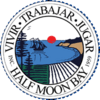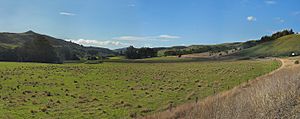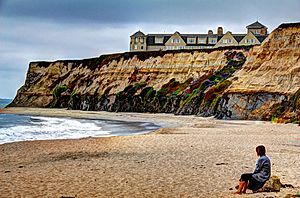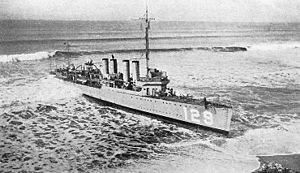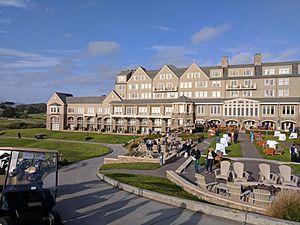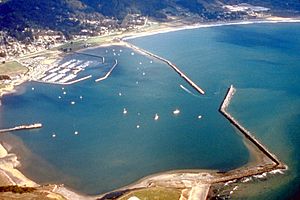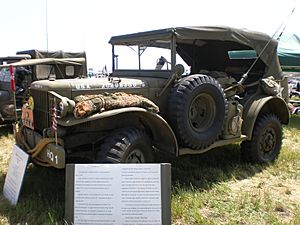Half Moon Bay, California facts for kids
Quick facts for kids
Half Moon Bay, California
|
||
|---|---|---|
| City of Half Moon Bay | ||

Aerial view of Half Moon Bay facing north
|
||
|
||
| Nickname(s):
"Home of the world-famous Half Moon Bay Pumpkin Festival!"
|
||
| Motto(s):
Vivir, Trabajar, Jugar (Live, Work, Play)
|
||
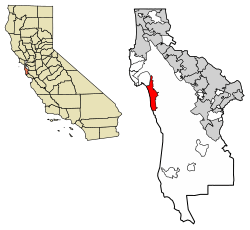
Location of Half Moon Bay in San Mateo County, California
|
||
| Country | United States | |
| State | California | |
| County | San Mateo | |
| Incorporated | July 15, 1959 | |
| Area | ||
| • Total | 6.25 sq mi (16.20 km2) | |
| • Land | 6.24 sq mi (16.17 km2) | |
| • Water | 0.01 sq mi (0.03 km2) 0.32% | |
| Elevation | 75 ft (23 m) | |
| Population
(2020)
|
||
| • Total | 11,795 | |
| • Density | 1,887.2/sq mi (728.09/km2) | |
| Time zone | UTC−8 (PST) | |
| • Summer (DST) | UTC−7 (PDT) | |
| ZIP Code |
94019
|
|
| Area code(s) | 650 | |
| FIPS code | 06-31708 | |
| GNIS feature IDs | 277528, 2410685 | |
Half Moon Bay is a coastal city in San Mateo County, California, United States, approximately 25 miles (40 kilometers) south of San Francisco. Its population was 11,795 as of the[update] 2020 census. Immediately north of Half Moon Bay is Pillar Point Harbor and the unincorporated community of Princeton-by-the-Sea. Half Moon Bay is known for Mavericks, a big-wave surf location. It is called Half Moon Bay because of its crescent shape.
Originally an agricultural outpost to Mission San Francisco de Asís, the town was founded in the 1840s first as San Benito, and then as its Anglo fishing community grew, it was renamed Spanishtown. In 1874, it was again renamed Half Moon Bay. After rail and road connections in the early 1900s, the town grew. .....
The city's infrastructure is heavily integrated with the coast, including the Pillar Point Harbor, major roads, and the fire department. The economy of Half Moon Bay is dominated by a handful of businesses, the biggest of which is the Ritz-Carlton Half Moon Bay which employs 500 people and is a major source of property tax and tourism income for the city. Because of this geography, a 2022 study[update] found that the city had over 123 buildings vulnerable to sea level rise.
Contents
History
Half Moon Bay began as a rural agriculture area, primarily used for grazing of cattle, horses, and oxen used by Mission San Francisco de Asis (established in June 1776). Following the secularization of the Mission, Tiburcio Vásquez received the Rancho Corral de Tierra Mexican land grant in 1839 and Candelario Miramontes was granted Rancho Miramontes (later known as Rancho San Benito) in 1841.
The community began to develop in the 1840s as the first real town in San Mateo County. Known originally as San Benito, the town was renamed Spanishtown and attracted a thriving fishing industry in addition to its continued importance to coastal agriculture. Spanishtown became a racially diverse community, settled by Canadians, Chinese, English, Germans, Irish, Mexicans, Italians, Scots, Portuguese, and Pacific Islanders. Regular stagecoach service was established with San Mateo; coaches also served the communities of Purissima, Lobitos, and San Gregorio. Levy Brothers opened a department store in downtown Half Moon Bay. Spanishtown was officially renamed Half Moon Bay in 1874.
The area grew very slowly, even after the Ocean Shore Railroad began serving the community in 1907. The construction of Pedro Mountain Road in 1914 provided better access to San Francisco and probably contributed to the demise of the railroad by 1920. The USS DeLong ran aground at Half Moon Bay 1 December 1921. During Prohibition "rum runners" took advantage of dense fog and hidden coves in the area to serve a number of roadhouses and inns, some of which operate today as restaurants. Real growth in the area came after World War II with the construction of numerous subdivisions, eventually leading to the incorporation of Half Moon Bay in 1959. The city preserves a historic downtown district which includes historic buildings dating as far back as 1869.
2008 economic downturn and subsequent recovery
In 2008, financial setbacks endangered the city's viability. The economic crisis severely affected tourism, which generates the most revenue, and that just at the time when the city had finalized a $18 million settlement over a property lawsuit. As the municipal budget was typically $14 million or less, city fathers had issued bonds with annual payments of approximately $1 million over 25 years. As a result of these combined fiscal obstacles, the threat of bankruptcy was very real. Dozens of meetings were held in order to decide where the budget should be cut and finally 75% of municipal employees were laid off and replaced with contract workers. Also, employee contributions toward retirement benefits were raised. However, the city council sought to regain the money paid in the settlement, believing that it should have been paid by the city's insurers. A lawsuit against the insurers was decided in 2013 and the insurer ordered to pay more than $13 million to the city; the costs of the lawsuit had been partially covered by the Association of Bay Area Governments.
Since then, the City's finances have shown great improvement. The City was able to retire the first of its two 30-year Judgment Obligation Bonds (2009A Series Bonds) a full 20 years early. The early retirement will save the City over $426,000 in annual General Fund expenses starting in 2015-16. The second set of Judgment Obligation Bonds (2009B Series Bonds) will be retired in 2019, 18 years ahead of schedule with a combination of annual payments from the City Budget and funds already on deposit with the Bond Trustee obtained in settlements with two of the City’s insurance carriers. The early retirement of the 2009B Series Bonds will reduce the General Fund budget expenditure by almost $700,000 per year and will provide funding for the annual debt service on the Lease Revenue Bonds for the New Half Moon Bay Library.
As of the publication of the Fiscal Year 2015/16 Budget the General Fund budget is balanced and has a structural surplus of $4.0 Million. The General Fund budget is also projected to have a significant structural surplus (revenues exceeding operating expenses) in the following four years according to revenue and expense projections from the City’s Finance Department. This means that the City will be able to fully fund the cost of day-to-day operations and services in Half Moon Bay over the next five years with a healthy annual surplus that can be used towards the cost of desired Capital Improvement Program projects and other needs.
Geography
Half Moon Bay is located at 37°27′32″N 122°26′13″W / 37.458840°N 122.436848°W, approximately 25 miles (40 km) south of San Francisco, 10 miles (16 km) west of San Mateo, and 45 miles (72 km) north of Santa Cruz. Neighboring towns include El Granada, Princeton-by-the-Sea, Moss Beach, and Montara to the north and Purissima, San Gregorio, and Pescadero to the south.
According to the United States Census Bureau, the city has a total area of 6.4 square miles (17 km2), of which, 6.4 square miles (17 km2) of it is land and 0.02 square miles (0.052 km2) of it (0.32%) is water.
It is situated on a bay of the same name. Major local industries include agriculture (houseplants, floriculture, Christmas trees, pumpkins, artichokes), fishing, and tourism. Historically, Half Moon Bay had been known as San Benito and Spanishtown.
A popular spot at Half Moon Bay is the 'Jetty,' or as it is sometimes called, 'The Breakwater.' This is a man-made break with unusual waves shaped by reflections from the breakwater at Pillar Point Harbor. Streams in Half Moon Bay include Frenchmans Creek, Pilarcitos Creek and Naples Creek.
Montara State Marine Reserve & Pillar Point State Marine Conservation Area extend offshore from Montara, just north of Half Moon Bay. Like underwater parks, these marine protected areas help conserve ocean wildlife and marine ecosystems.
Demographics
| Historical population | |||
|---|---|---|---|
| Census | Pop. | %± | |
| 1960 | 1,957 | — | |
| 1970 | 4,023 | 105.6% | |
| 1980 | 7,282 | 81.0% | |
| 1990 | 8,886 | 22.0% | |
| 2000 | 11,842 | 33.3% | |
| 2010 | 11,324 | −4.4% | |
| 2020 | 11,795 | 4.2% | |
| U.S. Decennial Census | |||
2010
The 2010 United States Census reported that Half Moon Bay had a population of 11,324. The population density was 1,757.1 people per square mile (678.4/km2). The racial makeup of Half Moon Bay was 8,580 (75.8%) White, 82 (0.7%) African American, 71 (0.6%) Native American, 490 (4.3%) Asian, 9 (0.1%) Pacific Islander, 1,710 (15.1%) from other races, and 382 (3.4%) from two or more races. Hispanic or Latino of any race were 3,563 persons (31.5%).
The Census reported that 11,306 people (99.8% of the population) lived in households, 18 (0.2%) lived in non-institutionalized group quarters, and 0 (0%) were institutionalized.
There were 4,149 households, out of which 1,264 (30.5%) had children under the age of 18 living in them, 2,373 (57.2%) were opposite-sex married couples living together, 293 (7.1%) had a female householder with no husband present, 156 (3.8%) had a male householder with no wife present. There were 208 (5.0%) unmarried opposite-sex partnerships, and 41 (1.0%) same-sex married couples or partnerships. 1,067 households (25.7%) were made up of individuals, and 538 (13.0%) had someone living alone who was 65 years of age or older. The average household size was 2.72. There were 2,822 families (68.0% of all households); the average family size was 3.24.
The population was spread out, with 2,533 people (22.4%) under the age of 18, 796 people (7.0%) aged 18 to 24, 2,587 people (22.8%) aged 25 to 44, 3,644 people (32.2%) aged 45 to 64, and 1,764 people (15.6%) who were 65 years of age or older. The median age was 43.2 years. For every 100 females, there were 95.1 males. For every 100 females age 18 and over, there were 93.8 males.
There were 4,395 housing units at an average density of 682.0 per square mile (263.3/km2), of which 2,944 (71.0%) were owner-occupied, and 1,205 (29.0%) were occupied by renters. The homeowner vacancy rate was 1.0%; the rental vacancy rate was 1.9%. 7,645 people (67.5% of the population) lived in owner-occupied housing units and 3,661 people (32.3%) lived in rental housing units.
2000
As of the census of 2000, there were 11,842 people, 4,004 households, and 2,774 families residing in the city. The population density was 1,829.8 people per square mile (706.7/km2). There were 4,114 housing units at an average density of 635.7 per square mile (245.5/km2).
There were 4,004 households, out of which 30.9% had children under the age of 18 living with them, 58.3% were married couples living together, 7.2% had a female householder with no husband present, and 30.7% were non-families. 23.1% of all households were made up of individuals, and 9.1% had someone living alone who was 65 years of age or older. The average household size was 2.75 and the average family size was 3.20.
In the city, the population was spread out, with 22.2% under the age of 18, 8.1% from 18 to 24, 31.9% from 25 to 44, 28.2% from 45 to 64, and 9.6% who were 65 years of age or older. The median age was 39 years. For every 100 females, there were 112.8 males. For every 100 females age 18 and over, there were 115.1 males.
The median income for a household in the city was $78,473, and the median income for a family was $92,204. Males had a median income of $60,913 versus $41,265 for females. The per capita income for the city was $37,963. 6.1% of the population and 3.4% of families were below the poverty line. 7.0% of those are under the age of 18 and 6.2% of those 65 and older were living below the poverty line.
Economy
- GoPro was started in 2002 in Half Moon Bay, and then moved its headquarters to San Mateo, in 2012
- Odwalla was based in Half Moon Bay, but then relocated its headquarters to Dinuba, on May 31, 2013
- The Institute for the Study of Knowledge Management in Education is headquartered in Half Moon Bay
Top employers
According to the city's 2023 Annual Comprehensive Financial Report[update], the top employers in the city were:
| # | Employer | # of Employees |
|---|---|---|
| 1 | Ritz-Carlton Half Moon Bay | 150 |
| 2 | New Leaf Community Market | 105 |
| 3 | Sam's Chowder House | 98 |
| 4 | Safeway | 65 |
| 5 | Rocket Farms Inc. | 62 |
| 6 | SP Plus | 50 |
| 7 | San Benito House | 49 |
| 8 | Pasta Moon Inc | 48 |
| 9 | McMahon Floral | 47 |
| 10 | Beach House LLC | 45 |
Pillar Point Harbor
The Pillar Point Harbor at the northern edge of Half Moon Bay offers a protected landing for boats and provides other marine infrastructure. In the late 1980s, a new master plan was developed for the Harbor. A variety of fish species have been identified in the harbor area. At the harbor, fishermen sell crab and fish catches straight off their boats at discount prices directly to the public, and restaurants will filet the fish for purchasers.
The Half Moon Bay Yacht Club has facilities at the harbor.
Arts and culture
Notable buildings
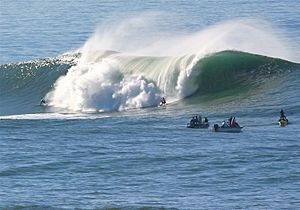

The city has four sites listed at the National Register of Historic Places: the Methodist Episcopal Church at Half Moon Bay, the William Adam Simmons House, the Robert Mills Dairy Barn, and the James Johnston House. The remnants of the village of Purissima, perhaps the only ghost town in San Mateo County, are four miles (6.4 km) south of the city, near the junction of State Route 1 and Verde Road.
There is an artist's collective, Colony of Coastside Artists, downtown has several galleries, and there are art classes and workshops available locally.
The Ritz-Carlton Half Moon Bay is a major employer. The hotel was used as the wedding venue for the 2003 comedy film, American Wedding.
Events
The Half Moon Bay Airport hosts an annual benefit event in April, Pacific Coast Dream Machines, which features aircraft and automobiles. Half Moon Bay also hosts an annual Art and Pumpkin Festival in October.
Parks and recreation
The region around Half Moon Bay contains several state parks and beaches, including:
- Half Moon Bay State Beach
- Poplar Beach
- San Gregorio State Beach
- Pomponio State Beach
- Fitzgerald Marine Reserve, located north of Half Moon Bay, is a refuge for plants and animals adapted to live at the shoreline.
At the north edge of the bay is the big wave surf area, Mavericks, off Pillar Point, where surfers challenge waves over 50 feet (15 m) tall. From 1999 to 2016, it was the location of the annual Titans of Mavericks competition.
Montara Mountain, located North of Half Moon Bay, is a popular outdoor recreation spot and home to the old Highway 1.
Education
The Cabrillo Unified School District serves the city. Schools include Half Moon Bay High School, Cunha Middle School and Hatch Elementary School although many students are bused to other Cabrillo Unified Schools (Farallone View Elementary and El Granada Elementary) in the unincorporated area north of the City and King Mountain off Skyline Boulevard south of Highway 92.
The city is served by the Peninsula Library System.
Media
- Half Moon Bay Review, the city's only newspaper, which has been in existence since 1898
- Coastsider, an on-line community news site
- Half Moon Bay Patch, online newspaper
Transportation
Primary road access is via State Route 1 (the Cabrillo Highway) from the north and south, and State Route 92 from the east.
The city is served by Half Moon Bay Airport.
SamTrans routes 294 and 117 provide service to Half Moon Bay from the Hillsdale Caltrain station in San Mateo and Linda Mar in Pacifica, respectively.
Notable people
- John Cardiel, skateboarder
- Jon Miller, Hall of Fame broadcaster for the San Francisco Giants
- Charlee Minkin (born 1981), Olympic judoka
- John Montefusco, former pitcher for the San Francisco Giants and Atlanta Braves
- Jay Moriarity, surfer and free diver, youngest person to surf Mavericks, depicted in the film Chasing Mavericks
- Al Pereira, professional wrestler, twice holder of the European Heavyweight Championship
- Dorothy Wagner Puccinelli, muralist and artist
- Richard Rhodes, Pulitzer Prize-winning author and historian
- Phil Schiller, senior vice president at Apple
See also
 In Spanish: Half Moon Bay para niños
In Spanish: Half Moon Bay para niños


